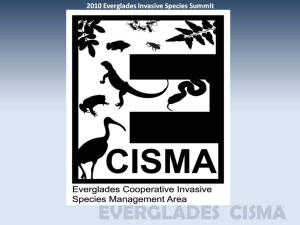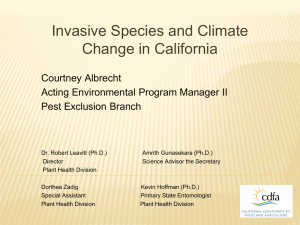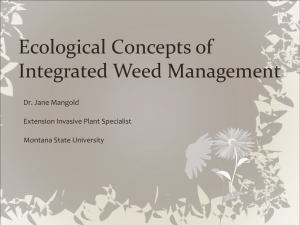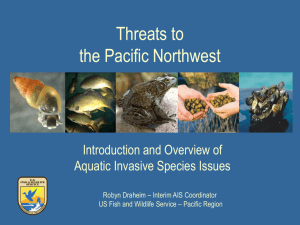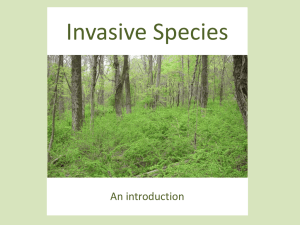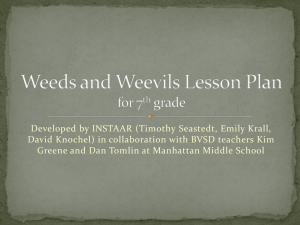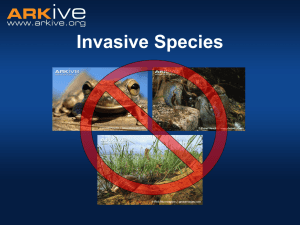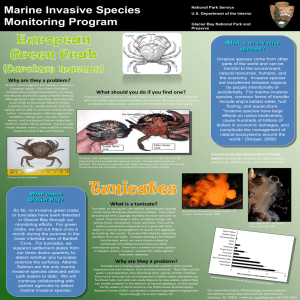CESU Presentation - Reduce Risks from Invasive Species Coalition
advertisement
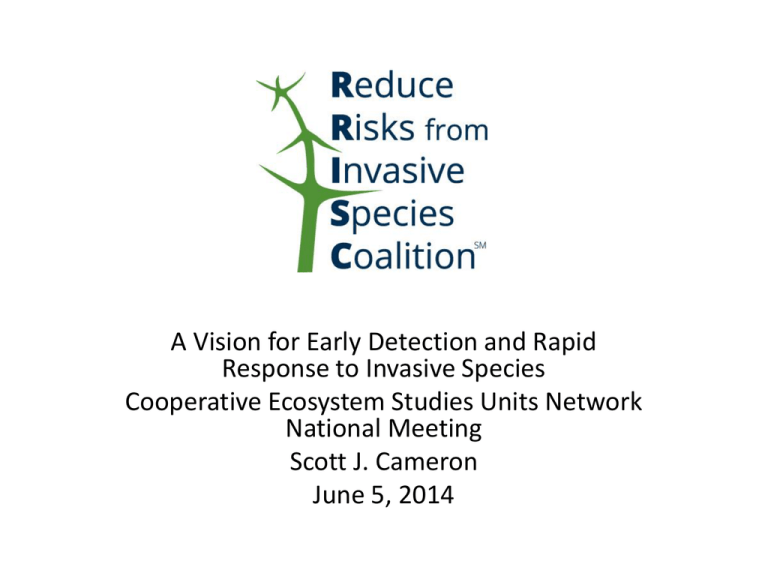
A Vision for Early Detection and Rapid Response to Invasive Species Cooperative Ecosystem Studies Units Network National Meeting Scott J. Cameron June 5, 2014 Why care about invasives? • Earth’s most serious and least understood ecological problem • $1.4 trillion annual hit to global economy • $128 billion annual hit to US economy • 43% of listings under the Endangered Species Act • Caused 20% of global extinctions since 1600 • Contributed to 50% of extinctions since 1600 • Invasive diseases kill and hospitalize thousands 2 What is RRISC? • Mission: RRISC educates Americans on the risks posed by invasive species to the economy, environment, and public health of the United States, and promotes cost-effective strategies to reduce those risks. • Vision: Engage a broad-based group of stakeholders and all levels of government in non-regulatory risk-based strategies to accomplish the mission. 3 RRISC Chronology • • • • • • • • • Incorporated in the District of Columbia, 3/7/14 Website launched, www.rrisc.org, 3/18/14 Officers elected, 3/24/14 Distinguished Advisory Board appointed, 5/2/14 Presentation to Invasive Species Advisory Committee, 5/13/14 Presentation to Office of Management and Budget, 5/16/14 Presentation to US Fish and Wildlife Service, 5/21/14 Filing with IRS for 501(c)(3) status, 6/2/14 Official Launch Event on Capitol Hill, 6/17/14 4 RRISC Goals • • • • • • • • • Protect biodiversity Reduce industry operating costs Create business opportunities Reduce the regulatory burden of the ESA Demonstrate success of nonregulatory solutions Focus public and Congressional attention Foster programs in conjunction with Congress Harness bipartisan Distinguished Advisory Board Recognize successful best practices 5 RRISC Strategies • Show how invasives threaten people, the economy, and the environment of every Congressional District • Support the annual National Invasive Species Awareness Week • Promote annual President’s budget request • Lay the groundwork for a national network of regional early detection and rapid response capabilities by sponsoring multi-stakeholder educational regional workshops around the country, in cooperation with State governments, federal agencies, and land grant universities 6 Why Early Detection and Rapid Response (EDRR)? • Prevention is imperfect • Perfect prevention would be exorbitantly expensive and socially unacceptable • EDRR represents defense in depth to eliminate new populations of invasives that infiltrate new habitats before they have time to get established 7 Hypotheses for EDRR • Regionally managed, not centrally directed • State government leadership, not federally driven • Multi-stakeholder, not single agency • Regions defined ecologically, and/or socioeconomically, politically • Land grant universities play critical role • Sensitive to regional priorities 8 Strategies for EDRR • Leverage existing models • Explore other models: CDC, National Contingency Plan (oil spills), Boise Fire Center • Expand APHIS authority • Federal cost-sharing • Facilitate improved federal partnering 9 Existing models for pieces of EDRR • Following slides courtesy of Chuck Bargeron, University of Georgia 10 Everglades Invasive Animal Web and Mobile Reporting System 10/1/2010 – 9/30/2015 Funded by National Park Service - Everglades • • • • • • • • Task 1: Provide for and make minor changes/additions/maintenance to EvergladesCISMA website and Animal portion of EDDMapS for Florida over five years. Task 2: Share data with Florida Fish and Wildlife Conservation Commission on monthly basis. Task 3: Attend Everglades CISMA Annual Summit on yearly basis. Task 4: Develop interface for “Power Users” to easily edit and amend reports to EDDMapS. Task 5: Streamline verification process with Florida Fish and Wildlife Conservation Commission. Task 6: Develop multi-page reporting form and integrate ID resources into reporting form. Task 7: Integrate NPS and FWC images into EDDMapS. Task 8: Develop EDDMapS Animals report App for Apple iPhone and submit to Apple for availability through Apple iTunes App Store that include ability to report exotic animal sightings and includes reptile identification guide. Detecting and Mapping New Invasive Species Occurrences 4/15/2010 – 12/30/2014 Funded by National Park Service – National Capital Region • • • • • • Provide distribution maps for selected invasive species across the mid-Atlantic states at point to County level through individual species reports entered by online reporting form and through the compilation and conversion of data from existing electronic data sets into one central location. Establish a user-driven system for automatic e-mail notification when data on selected species is submitted for selected areas. This will make reporting of new detections easier and decrease response times which will lead to more efficient and cost effective control programs. Create an avenue for knowledge sharing between the Mid-Atlantic region parks and other agencies, organizations, and individuals. Provide data to refine regional, state and park priority lists and determine incipient invasive species. Provide color-coded or other method for identifying and distinguishing initial infestations, treated infestations, and eradicated infestations, so as to maintain and not lose invasion history. Share data with other projects and national databases such as the USDA NRCS PLANTS Database. Florida Invasive Species Partnership & Cooperative Invasive Species Management Area Website Development, Enhancement & Implementation Multiple Projects Funded by U.S. Fish and Wildlife Service • Implement web template for any new CISMA (needing a web presence) • Host and update www.FloridaInvasives.org website. • Host and update CISMA web sites on www.FloridaInvasives.org website. • Maintain EDDMapS for any hosted CISMA website • Share invasive plant data with Florida Natural Areas Inventory NPS Invasive Plant Alert – a mobile app 9/4/2012 – 2/28/2014 Funded by National Park Service – Biological Resource Management Division • • • • • • • • • • NPS/UGA to identify and outline all pertinent user workflows (and inherent requirements) that this project is intended to accommodate. NPS/UGA to refine design of mobile application and park configuration interface to ensure accommodation of all workflows/requirements and adoption of pertinent technology. UGA to develop NPS-branded mobile application (for iOS). UGA to develop website that facilitates administration of both user accounts and park/site configuration details (i.e. park list of invasive plant species). NPS to review, test, and approve functional operation of application and website prior to publishing/release. UGA to make application available through iTunes (App Store). NPS/UGA to jointly conduct announcement/training to priority park unit staff. UGA to provide comprehensive application hosting and technical support to priority parks for one year following initial implementation of the application. UGA to specify the cost, on a park-by-park basis, of establishing additional park units for application use/support. UGA to specify the annual application hosting/support cost on a park-by-park or Service-wide basis. Evaluating Potential Resources to Track and Warn the Public of Invasive Plant Species Impacts in Southern Florida 9/1/2013 – 8/30/2015 Funded by U.S. Army Corps of Engineers The University of Georgia will work with the U.S. Army Corps of Engineers to complete the following tasks: – Evaluate existing watershed scale / GIS-based data sets of invasive plant species to locate, establish persistence, and track movement of invasive species in their respective ecosystems – Test resources for their capability of generating public warning reports of invasive species distribution and possible negative impacts from these colonies – Provide public access to this information for situational awareness and strategic planning for the control and management of increasing invasive species populations Invasive Plant Identification and Record Input Smartphone App for Western Alaska 3/1/2014 – 9/30/2015 Funded by Western Alaska Landscape Conservation Cooperative This project will develop applications for Apple iOS (iPhone/iPad/iPod Touch) and Google Android devices. This application will: – Provide information about invasive plants already known to be in the area based on the user’s phone GPS location and/or community reference in comparison to the Alaska Exotic Plants Information Clearinghouse (AKEPIC) database – Provide (limited) decision support to assist in properly identifying the invasive plant and distinguishing it from native plants that may be similar in description. – Provide very basic control information letting users know if it is safe to pull up the invasive plant by hand or directing them to a site for more detailed treatment information. – Have low band-width requirements so as to facilitate use in remote regions of Alaska. – Allow the user to upload data (photo, GPS location, date, size of plant cluster, etc.) into a database for review by an expert in invasive plant identification and potential eventual addition to the AKEPIC database. Issues to explore • Appropriate functions? – – – – – – – – Interdiction at the borders/ports? Monitoring? Identification? Reporting? Research? Education? Rapid response? Post-eradication surveillance? • How does one define the “region”? • Will deferring to regional priorities cause gaps? – Terrestrial and aquatic? – Animal and plant? – Diseases? 22 The right regions?? 23 Issues to explore • How to leverage technology? – Smart phones with GPS – Too many apps? • Standards? • Software compatibility? • Authoritative information? • How to leverage CESUs? 24 Issues to explore • What capabilities would a regional EDRR network need? – – – – – – – – – – – – Program Management Office? Volunteer coordination? Rapid Response dispatch function? Database management, distributed or centralized? GIS? Public outreach/alert capability? Public Affairs? Intergovernmental coordination? Research? Systematics? Budget? Staff, dedicated/virtual? 25 Issues to explore • Governance? – Role of federal agencies? – Role of state agencies? – Role of local governments? – Role of industry, individually and/or through trade associations? – Role of universities? – Role of non-governmental organizations? 26 Suggestion • Organize regional EDRR workshops in conjunction with leading land grant university/CESU sponsor • Invite all stakeholders in defined region • Goal: Define what EDRR would look like in the region – – – – – Capabilities Priorities Functions Governance Funding 27 Contact Scott Cameron Scott.Cameron@rrisc.org 703 909 2880 28
